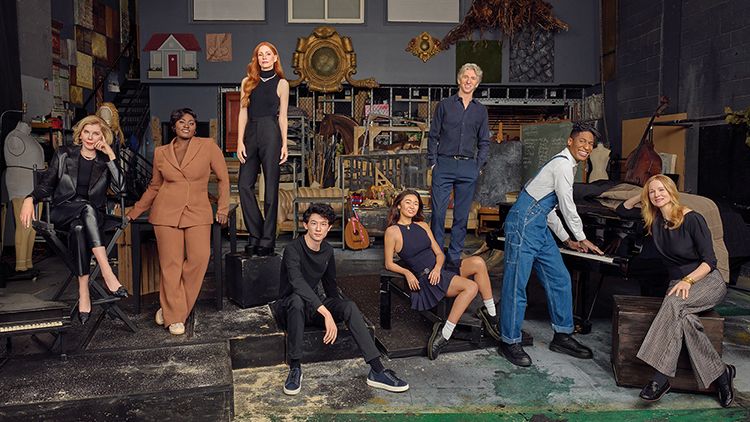For Christine Baranski, the most evocative space at the Juilliard School isn’t a black box theater or a rehearsal room where she cut her teeth as an
For Christine Baranski, the most evocative space at the Juilliard School isn’t a black box theater or a rehearsal room where she cut her teeth as an actor. “I get really emotional when I set foot in the elevator,” she says with a sigh. She remembers its “new car smell” when she rode it in the early 1970s, as part of the third class to ever study in the drama school. And she remembers, just as viscerally, the people she rode in it with. “I was in the elevator once with Leonard Bernstein, with Martha Graham, George Balanchine,” she says. “I was in the elevator once with Maria Callas.”
If you know anything about Juilliard, it’s probably that it is where some of our greatest artists learned to be great. The school, established in 1905 as the Institute of Musical Art in Manhattan’s Greenwich Village, has long given students world-class training in their chosen discipline: dance, drama, or music. Last September the drama department’s MFA program went tuition-free, as the Yale School of Drama had a few years before. Now—and this is why we gathered some celebrated alumni for a portrait backstage at the school’s Peter Jay Sharp Theater—Juilliard has announced that it intends to go entirely tuition-free. For every student. The great work has already begun. Starting this fall, 40 percent of Juilliard students will attend the institution at no cost.
Reaching the school’s ultimate goal will take earnest fundraising, but other elite educational institutions are increasingly thinking along the same lines. (Harvard College, for instance, announced that it will be tuition-free for families with incomes of under $200,000.) Since he became Juilliard’s president in 2018, Damian Woetzel, a former principal dancer with the New York City Ballet, has worked to make the school accessible to all students, not only increasing financial aid but also designating several programs tuition-free already. Juilliard currently costs north of $50,000—not including room and board—and more than 95 percent of the students already receive some support from the school. “The overall goal is to move steadily more tuition-free—to that ultimate place—and make sure that talent is the opportunity, not the ability to pay for it,” Woetzel says.
That opportunity is strenuous to come by. Juilliard’s Drama Division typically accepts 18 students a year—8 to 10 undergraduate students and 8 to 10 graduate students—making it one of the most competitive and sought-after drama programs in the world. Even Baranski had a tough time getting in. “They put me on a waiting list in the spring,” she says. It wasn’t because she showed a lack of promise: “They thought that the space between my teeth might’ve been causing a sibilant s,” she says. “Over the summer, I had dental work.” After capping her teeth and taking speech therapy classes, Baranski reauditioned for the speech teacher and the Drama Division’s artistic director, Oscar winner John Houseman. “I did a paragraph that was filled with nothing but s-words,” she recalls. It must have done the trick, because the moment the speech teacher signed off, Houseman accepted her on the spot. To this day, Baranski says, it’s “one of the most moving moments of my life.”
Jessica Chastain calls Juilliard her “home away from home.” The Northern California native studied at the school in the early aughts, immersing herself in roles like Arkadina in The Seagull and honing the craft that would eventually win her an Oscar. “When you’re training, you have no idea what little seeds you’re planting and growing inside of you—how it’s going to develop into your career,” Chastain says. The first from her family to attend college, she struggled to afford tuition, particularly on top of the hair-raising cost of living in New York City. “I was so stressed out about money,” she says. She worked part-time in the library and the student affairs office on her lunch breaks and took out loans—“a lot” of them—to get by. “I couldn’t even afford to go to a restaurant. So it was all the cafeteria,” she says. Asked how the food was, she winces. “I mean, it’s a cafeteria,” she quips.
After Chastain received the Robin Williams Scholarship, which covered the last two years of her four-year degree, she could breathe more freely. “Having that cushion was like, Okay, I can finish,” she says. “I can get my degree. I’ll still be in debt, but I won’t be consumed and overwhelmed by it.”
Danielle Brooks had to pay full tuition when she left South Carolina for Juilliard. “I did not have the scholarship money,” she says. “My parents had to refinance our home for me to come here.” Even that wasn’t enough. “Unfortunately, my godmother had passed away and, to my surprise, left me $20,000 in her will. That was what helped me to start my first semester at Juilliard.”
Brooks made it through the program, starring in productions like A Raisin in the Sun and Clybourne Park while working multiple front-desk jobs at the school, which she stuck with after graduation. “I remember nights of crying right after I graduated,” she says. “Not having the money and working all these odd jobs, trying to pay for college.” Brooks is now a Tony-and Oscar-nominated actor for the stage and screen versions of The Color Purple. “My cheeks hurt from the joy of surviving this place,” she says.

COMMENTS